Subcategories for this page ...
- Architects
- Artists
- Creative directors
- Fashion designer
- Graphic designers
- Interior designers
- Toy designers
- Video-game designers, creators
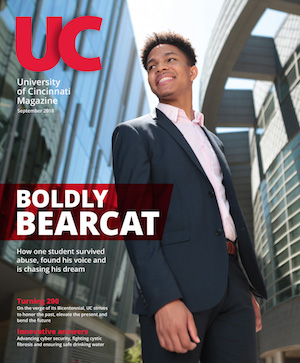 September 2018
September 2018
Boldly Bearcat
Finding his voice
Danger in the tap
Virtual defense
Global game changer
Celebrating UC's Bicentennial
 Past Issues
Past IssuesBrowse our archive of UC Magazine past issues.
Michael Graves is internationally renowned for his postmodern architectural works, including UC's Engineering Research Center, Cincinnati's Riverbend Music Center and the Swan and Dolphin Resort at Walt Disney World [right]. A professor of architecture at Princeton University and president of the architectural firm that bears his name, Graves was honored by President Clinton in 1999 with a National Medal of Arts and in 2001 received the American Institute of Architects' highest honor, the gold medal. He also designs aesthetically pleasing household objects, many of them designed especially for Target department stores.
Michael Bierut is vice president of design at Vignelli Associates, a partner at Pentagram and a member of the Art Directors Club Hall of Fame. He also has participated in the feature film “Helvetica,” earned the American Institute of Graphic Arts Medal (the profession’s highest honor), regularly contributed to the Public Radio International program “Studio 360” and had his works included in the permanent collections of a number of museums, including the Museum of Modern Art and the Cooper-Hewitt National Design Museum.

UC's CARE/Crawley Building, designed by Erik Sueberkrop
Erik Sueberkrop is chairman and founding principal of the architectural firm Studios Architecture and was design principal for UC’s new Center for Academic and Research Excellence (CARE)/Crawley Building on the Academic Health Center campus. In 2002, he won the Chicago Athenaeum American Architecture Award for the building design. Studios Architecture has offices in San Francisco, Los Angeles, New York, Paris and Washington, D.C. The firm has designed headquarters for MTV, E*Trade, Turner Broadcasting Systems Europe, Silcon Graphics (later sold to Google), Bloomberg News and other high tech clients.
(1935-2006)
Dick Blinder was a champion of historic preservation and a founding partner of Beyer Blinder Belle. He was best known for his cultural and performing arts projects, including the renovation of New York City's Grand Central Station, Ellis Island, Ford Center for the Performing Arts on Broadway (which he created by merging two historic theaters into one), Rubin Museum of Art, Japan Society and Hilton Theatre. (See "DAAP architect salvages historic theater," UC Magazine, January 1999)
Darrell Daniel was one of the architects to design Kings Island, which opened 1972. He also led redesign work on Coney Island’s rides and shows in the 1960s, including the Log Flume.
Emilie Rottman, DAAP ’08, and colleague James Ramil won first-place in an international competition to revitalize downtown Detroit with a focus on a historic site. Rottman and Ramil’s entry was the People’s Choice winner of the 2013 “Redesigning Detroit: A New Vision for an Iconic Site” contest. (See complete story.)
Walt Handelsman is the two-time Pulitzer Prize-winning political cartoonist at Newsday in New York, with work is nationally syndicated to more than 200 newspapers around the country and the world. His work frequently runs in Newsweek, Time, the New York Times, USA Today, the Washington Post and the Chicago Tribune. In addition, he has been a featured guest on CNN, Fox and ABC's "Nightline." Handelsman received the Pulitzer Prize in 2007 and 1997, as well as the 1989 and 1993 National Headliner Award, the 1992 Society of Professional Journalists Award, the 1996 Robert F. Kennedy Journalism Award and the 2003 Scripps Howard National Journalism award. In 2006, he began creating animated editorial cartoons for Newsday, viewed by millions of fans. He is also is the author of eight collections of his editorial cartoons as well as a children's book.
Tom Tsuchiya is a sculptor who created life-sized likenesses of Joe Nuxhall, Frank Robinson, Ted Kluszewski and Ernie Lombardi at the Cincinnati Reds' Great American Ball Park, as well as mascot D'Artagnan at Xavier University. In 2009, he designed and sculpted a piece for the Madden Most Valuable Protectors Award for the NFL, which was unveiled at the Super Bowl. In September 2011, his bronze sculpture of the famous baseball catcher Johnny Bench was unveiled at the Reds Hall of Fame at Great American Ball Park. In 2010-12, he was working on a 50-foot-tall Jesus for the Solid Rock Church on I-75 in Monroe, Ohio, where the previously recognizable "touchdown Jesus" (or "butter Jesus") was struck by lightening, then burned to the ground in June 2010.
LINK: See more photos and read the UC Magazine story on Tsuchiya.
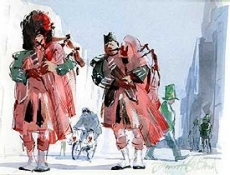
A painting by David FeBland
David FeBland is an internationally known artist who has won more than a dozen awards.
LINK: See feature article on FeBland, "Master of urban realism," UC Magazine, October 2000.
Jim Dine is a groundbreaking avant-guard painter, sculptor, printmaker.
Tom Wesselmann was in the forefront of America’s Pop Art movement, along with Andy Warhol and Roy Lichtenstein. He passed away in 2004.
David Opdyke is an artist, sculptor who often works with wood and a hammer. He has exhibited internationally and has received media coverage from the New York Times, Vanity Fair and the Washington Post.
P. Craig Russell is an award-winning graphic novelist who began with Marvel Comics, then became famous for comic adaptations of operas, plays and fairy tales. Russell first began drawing for Marvel Comics while still attending UC. ("I would work on stories, get graded, then mail them to Marvel and get paid. It was a terrific way to do my senior year.") He inked more than 300 pages of "Star Wars" comics for Dark Horse while adapting "Wagner's "Ring" into a 14-book series. He has won several Eisners, the Oscars of the comic world, and received the Harvey Award for Best Artist in 1997.
LINK: See "How to take opera from stage to page (and make comics out of classics)," UC Magazine, May 2002.
Shane Wolf and his paintings are receiving international attention. The design major was honored with the prestigious Prix Taylor (Taylor Prize) at the Paris’ Grand Palais in 2011 for his painting “Soumission.”
Wolf, originally from Reading, Ohio, received the prize from among 2,500 artists showing in “Art en Capital” at the Grand Palais. Because of this win – by a rare unanimous vote among the judges – he was invited to subsequently show another painting at the Carrousel du Louvre in Paris, for the 150th anniversary of the National Society of Beaux-Arts. From among 700 works, Wolf's oil-on-canvas painting, "Impetus," was honored with a bronze medal.
LINK: Read more.

Stan Herman
Stan Herman pioneered the "designer uniform" with clients such as FedEx, McDonalds, Amtrak, Avis, TWA, United Airlines and Jet Blue. For more than 10 years, he has been designing upscale clothes for QVC and is especially known for his chenille robes. Early in his career, he won the Coty Fashion Critics Award three times for the creation of Mr Mort, a phenomenon of ready to wear in the 60's and early 70's. In 1996, he become president of the Council of Fashion Designers of America, which later gave him a Lifetime Achievement Award. In 2006, he won the Geoffrey Been Lifetime Achievement Award at the Council FDA Awards. He has also been pioneer in designer activism, being the first to commercialize faux fur and use his first showing of that line to raise funds for the Central Park Zoo.
LINK: See feature article, "Stylish and comfortable," UC Magazine, October 2000.
Joe Stitzlein is global creative director for the Google Brand Studio. Prior to being named to that job in 2013, he had helped build brand communications and experiences for Nike, Apple, FedEx, P&G, the AIGA and Pixar. His work has been featured in Adweek, the AIGA annual, the Annual of the Type Director's Club, among others.
Bruce Blackburn conceived the symbol and identity program for the American Revolution Bicentennial Commission in 1976 and also designed the 1975 NASA logo (known at the "worm" and used for 17 years), Sigma Phi Epsilon's red heart logo and an Absolute vodka logo.

Two of Blackburn's designs

Sam Lucente, Hewlett-Packard's first and current VP of design, previously produced IBM's Thinkpad 560 and 710, Leapfrog and Netscape's Constellation platform; his work is part of permanent collections at the New York Museum of Modern Art and the Smithsonian National Design Museum.

John Lutz worked on the team that created the FedEx logo while a cooperative-education student at UC. On the logo at left, notice how the negative space between the E and X forms an arrow. Read more about the famous design.
Kevin Roche is an internationally known interior designer who leads global consultancies related too merchandising and strategic planning. Currently, he is principal of Roche Design Strategy; coordinating work at Le Bon Marche, a Moët-Hennessy Louis Vuitton company in Paris, and serving on the advisory board of Michelgroup, Zurich, Switzerland, where he was formerly the executive director.
Other previous positions include CEO of Fitch Worldwide, president and CEO of FRCH Design Worldwide, and senior vice president of DFS Group/LVMH, a luxury retailer in six global regions. His work with international brands has included Mercedes-Benz, Calvin Klein, Marriott International, Sony Loews Entertainment, BP International, Viacom, Samsung, Starbucks, Harley-Davidson, Nike, Timberland, Limited Brand's Victoria Secret, Discovery Channel Retail and Macy’s.
LINK: Read about his participation in the '08 Kautz Alumni Masters series.
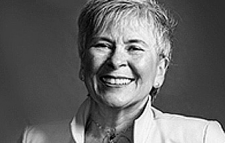
Eva Maddox is an award-winning interior designer and design principal of Perkins + Will Associates, Chicago. She is the founder of Eva Maddox Branded Environments. In collaboration with Bernard Tschumi Architects & Glaserworks, her firm designed UC's Richard Lindner Center and the George and Helen Smith Athletics Museum inside. That work received an American Institute of Architects' special recognition award for interior architecture in 2008. Maddox is also a co-founder and program director of Archeworks, an alternative design school in Chicago. In place of a traditional curriculum, students work in multidisciplinary teams with nonprofit partners to create design solutions for social and environmental concerns.
She has received more than 100 awards for design excellence, including the
2000 Star Award from the International Interior Design Association, the Women Who Make a Difference Award from the International Women's Forum and induction into the Interior Design Hall of Fame. Fast Company magazine called her one of the "change agents ... designers and dreamers who are creating your future." In 2011, Contract magazine presented her with the Legend Award for having “contributed in a significant way to raising the standards of commercial interior design and architecture” and for developing a "personal brand that is one of the most highly respected throughout the architecture and design community."
An '09 inductee into the Interior Design Hall of Fame, Nick Luzietti is design principal of VOA Associates in Chicago. Specializing in architecture, interior design and "ReUse + Preservation," Luzietti has dealt in commercial applications across the globe, including education, government, health care and hospitality. His work has been recognized by prestigious design competitions including American Institute of Architects, International Interior Design Association and American Society of Interior Design. According to Interior Design magazine, "What sets Luzietti apart from the rest is his listening skills; he talks to his clients at length and designs with their interests and passions in mind, testing the bounds of his creativity within the parameters of his clients’ visions."
The magazine also points out, "He is loved and revered both for his outrageous earthly behavior and passionate off-screen crusade as comical ambassador for all living things, including designers." A good example of that outrageous behavior came at his Hall of Fame induction, when he donned sunglasses and a Sergeant Pepper jacket then launched into an impromptu one-man variety show "that had us laughing out loud – almost to the point of tears," said Danielle De Vita, editorial director of Design-Calendar.
LINKS
Jim Swearingen served as lead designer for Kenner's original "Star Wars" line when the movie debuted in 1977. Swearingen also contributed to many popular product lines, including PlayDoh, Spirograph, Baby Alive, Care Bears and Strawberry Shortcake. After Hasbro bought Kenner in 1992, Swearingen-and coworkers Tom Osborne, DAAP '75, and Tim Effler, DAAP '74 started their own company, which often specialized in licensed products from movies such as "Alien," "Jurassic Park," "Men in Black" and "Pirates of the Caribbean II: Dead Man's Chest." Their Ultimate Black Pearl Pirate Ship play-set design landed a 2007 Toy of the Year Award, equivalent to the toy industry's Oscars.
LINK: Read UC Magazine article about Swearingen.
Jim Mariol designed the nation's best-selling car, the Cozy Coupe toy car, in '79 for Little Tikes. The bright red and yellow foot-powered kid car became one of the most popular toys in history, with more than 10 million in the market. In June 2009, to commemorate the 30th anniversary of the car, the first Cozy Coupe off of the line from 1979 was accompanied by a special 30th anniversary edition and inducted into the Crawford Auto-Aviation Museum in Cleveland.
LINK: Read the UC Magazine feature on Mariol.
(1898-1993)
Abe Bookman invented the Magic 8-Ball, a fortune-telling toy currently manufactured by Mattel. Bookman briefly attended UC's McMicken College of Liberal Arts, but needed to quit to care for his mother and siblings when his father died. Later he earned a degree at the Ohio Mechanics Institute (OMI), which eventually merged with UC.
During World War II, Alfred Carter in Cincinnati created a tube-like fortune-telling toy based upon a "spirit writing" device used by his mother, a successful clairvoyant. To produce it for wider distribution, OMI grad Bookman was brought into a partnership.
In 1944, Carter filed a patent on the device and attached Bookman's name to the patent. Their revised creation was originally sold as "Syco-Seer: The Miracle Home Fortune-Teller."
Before the patent was granted in '48, Carter died, and Bookman modified the product, this time encasing it in an iridescent crystal ball, which attracted the attention of Chicago's Brunswick Billiards company. In 1950, that company commissioned the black and white 8-ball that we know today.
Need we say more? Sources point to no.
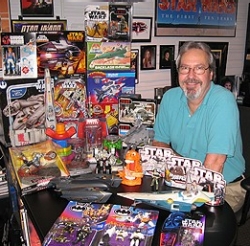
Mark Boudreaux, senior principal designer of Boy's Toys at Kenner/Hasbro, worked on toys for all six "Star Wars" films.
Mark Boudreaux is senior principal designer of Boy's Toys at Kenner/Hasbro. He worked on toys for all six "Star Wars" films, did the preliminary design development on Kenner's original Millennium Falcon toy in the '70s, has been the designer of Galactic Heroes and worked with LucasFilm Ltd. on its new animated "Star Wars" TV series.
He also has his face on a Star Wars action figure — the Rebel Trooper, the Rebel Blockade Runner Trooper and an exclusive AT-ST driver. The company allowed portraits of members of the team to be used on background characters, he says.
LINK: Read his UC Magazine story.
(1927-2010)
Ronald Bruce Howes Sr. created the Easy-Bake Oven, while director of research and new product development at Kenner Products in the early 1960s. The toy oven that was inducted into the National Toy Hall of Fame in 2006 at the Strong National Museum of Play in Rochester, N.Y. At that time, 23 million ovens had been sold and more than 140 million mixes. Howes was also involved in the development or refinement of Kenner's Spirograph, Give-a-Show Projector and Close-and-Play Record Player. He continued to invent items during his entire life, including high-tech defense weaponry devices and electrostatic printers.
LINK: Read the UC Magazine feature on Howes, plus news on today's oven.
David Laughridge was a key player on the design team that invented the Nerf ball in 1969. He also named the product, marketed as the "world's first official indoor ball," based upon the name of a foam used in dragster racing at the time. That was when he was director of research and new product development at Parker Brothers, but he later pursued a career with Lionel trains and is now the owner of Dr. Tinker's Antique Toy Trains Parts and Service in Lexington, Mass., where he fixes Lionel trains and stocks hundreds of parts for model train enthusiast.
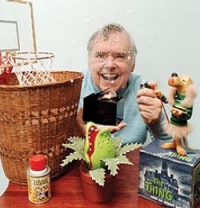
Don Poynter, hidden by foam sprayed from a trick lighter, shows off some of his inventions.
Don Poynter was a novelty entrepreneur who created the first basketball backboard for a wastebasket, "The Thing" coin box featured on the Addams Family (14 million sold), Uncle Fester's mystery light bulb (also featured on the show), crossword-puzzle toilet tissue, the Jayne Mansfield hot water bottle (which aired on the Jack Parr show on TV), the world’s smallest working record player (sold with 39 tiny records that Poynter recorded with real orchestras) and a Steer-N-Go landscape for Matchbox cars (which grossed $75 million in its first year).
LINK: See UC Magazine feature and photo gallery on Poynter's novelties.
Dan Meyer was brand manager with Jakks Pacific, a major toy and leisure-product company in Fort Lauderdale, Fla., when he designed the action figures and play set related to the movie "The Chronicles of Narnia: Prince Caspian" in '08. In doing so, he placed a likeness of his own face on the Telmarine soldier action figure (one of the bad guys, shown at far right).
In 2009, he became director of marketing and design at the newly founded The Bridge Direct in the Miami/Fort Lauderdale area. By Christmas 2012 and ’13, the company had released two lines of Hobbit toys (four of them pictured here) to coincide with Peter Jackson's two Hobbit movies and was on its way to becoming one of the top toy companies. The Bridge Direct has also produced licensed toys for Frankenweenie, Looney Tunes, Arthur Christmas, Justin Bieber, the Power Rangers and Jackie Evancho.
LINKS
In 1991, Mike Hoeting co-founded Bang Zoom Design with classmate Sean Mullaney (see below). Hoeting is now president of eight-person toy-invention and design firm in Walnut Hills. Among the more than 100 inventions the company has licensed are the Barbie Puppy Swim School, Tyco's Tantrum radio-controlled car, Playskool's Roll 'n' Rattle ball, Fisher-Price's Big Bubble Machine and Nickelodeon's Rugrats. In 2004, Bang Zoom's Hokey Pokey Elmo won the industry's Toy of the Year award. Hoeting says his favorite toy design was the RC Xtreme Cycle, which was made by Tyco and owned by Mattel.
LINK: Read UC Magazine article about Hoeting.
Sean Mullaney co-founded Bang Zoom Design in 1991 with DAAP grad Mike Hoeting (see above). Mullaney left the company in 2002 and opened Toy Lab, a store where children could invent toys from recycled toy parts. In 2009, he founded Quiggie Design, a toy, game and idea invention company. Mullaney holds more than 16 patents and has licensed more than 60 toys, games and products to Mattel, Hasbro, Milton Bradley and others.
LINK: Read UC Magazine article about Mullaney.
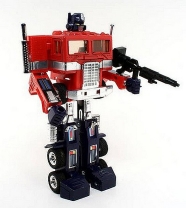
Bono had a hand in designing the Transformer Optimus Prime
Steve Bono is a toy designer, who, at one time, was head of design for Hasbro's international Action Man line. Bono had previously worked for Kenner (now a Hasbro subsidiary) and personally had a hand in developing a number of Transformers, including Optimus Prime, Nemesis Prime and Decepticon Rumble. He developed action figures for "Batman Forever," "Batman & Robin," "Star Wars" and "Indiana Jones and the Kingdom of the Crystal Skull" toy lines. Bono also helped design figures for the "G.I. Joe: The Rise of Cobra" movie.
.

Alumnus Eric Tscherne designed the Hot Wheels Sho-Stopper car.
Eric Tscherne is a 2011 inductee of the Diecast Hall of Fame for his work as a Hot Wheels designer from 1998 to 2004. Currently, he is the design director for preschool toys at Spin Master Toys, managing a variety of licensed toy lines, most recently for the animated film, “Monsters University.”
Tscherne really made a name for himself with his work at Mattel on Hot Wheels and at Jada on brands like Big Time Muscle. “I designed over 25 $1.00 Hot Wheels cars. Some are scale renditions of full-size cars but most of mine were of my own original designs.” A picture of one of his original designs, Sho-Stopper, was featured on all of the 1/64-scale basic car packaging for two years.
.
.

Mattel's "Whiplash" remote control car was released in 2002 with more than one million sold.
The innovative Vanderbeeks, Jon and Sarah, started Sweet Spot Studio in 2006. Located in Edgewater, N.J., the company now has a team of designers creating toys, giftware and packaging.
An earlier creation of Jon's is "Whiplash," a stunt car he designed while part of The Obb invention firm. The car can flip and roll by remote control and was released by Mattel Wheels under the Tyco name in 2002. According to the Sweet Spot website, more than one million of the cars were sold.
LINK: Sweet Spot Studio
Tim Conroy is the owner of Sculpco, a Cincinnati firm that designs action figures for movies, comic books, TV shows, wrestling and video games, including Star Wars, Batman, Spiderman, Pirates of the Carribbean, SpongeBob SquarePants, Power Puff Girls and Dragon Ball Z, to name a few.
LINK: Read UC Magazine article about Conroy.
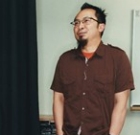
Randy Pagulayan
Randy Pagulayan is the manager of the User Research Group for Microsoft Game Studios, where he led research efforts on Xbox games, including Halo 2 and 3. His team pioneered the use of controlled experimental research methods for the purpose of improving the user experience in computer and video games. Published in several journals, Pagulayan has co-authored book chapters on user-centered design in games, has spoken internationally and was featured in a cover story in Wired Magazine. In 2010, National Public Radio interviewed him about the popularity of the video game Halo 3.
LINK: Read his UC Magazine story.

Carroll's Wraith from Diablo II
Evan Carroll designed creatures for three versions of Diablo II for Blizzard Entertainment. After its debut as the No. 1 selling PC game in January 1997, the original Diablo sold more than two million copies within the next two years. Diablo II was released in 2000 and made the Guinness Book of World Records for being the fastest selling computer game ever sold, with more than 1 million units sold in the first two weeks of availability. The Wraith (pictured at right) is one of the creatures Carroll designed for Diablo II. Today, Carroll is a film director, screenwriter and animator. He co-directed and co-animated the film "Legends from Camp," which was named Best Animated Short at the RiverRun International Film Festival in 2004. The eerie film about the internment of Japanese-Americans during World War II can be seen here.
LINK: See "Monster man: Alumnus creates characters of computer game sequel," UC Magazine, July 1999.
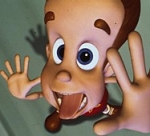
Jimmy Neutron
Mike Gasaway designed the animation on "Jak and Daxter," PlayStation II. He was also the lead character animator for the movie, "Jimmy Neutron: Boy Genius,” which was an Academy Award nominee for Best Animated Film in 2001.
LINK: See his Emmy-nominated TV credits.